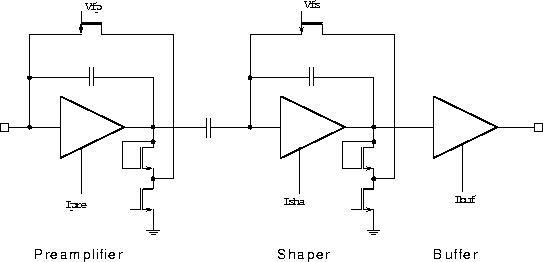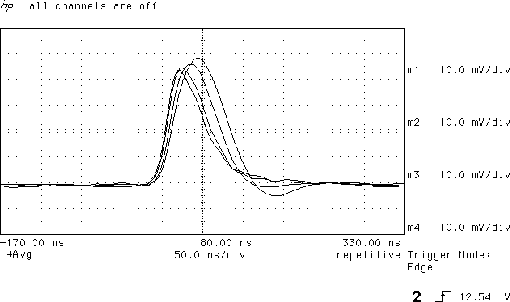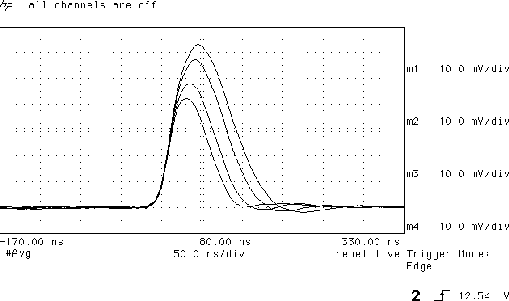



Next: The comparator
Up: Analog Signal Processing Architecture
Previous: Overview
Helix128-2 uses the Helix2.1 frontend (fig. 2)
which has been carefully optimized
with respect to noise, pulse shape (peak time and undershoot),
linearity, space and power consumption. More detailed descriptions
can be found in [2] and [3].
Figure 2:
Helix2.1 frontend
 |
To set the frontend operation mode and
to compensate for radiation damage the frontend bias voltages and
currents (not to be confused with the power supplies +2V,0V,-2V)
may be adjusted via programming of the corresponding DAC registers
as explained in section 4. The nominal values are
listed in table 1.
- Ipre sets the preamplifier bias current. With Ipre
being above a threshold of
 100
100 A no impact on the peak
time is observed [7]. A higher Ipre current reduces
noise, so that a noise degradation of the preamplifier due to decrease
of the gm of the input transistor can be cured by increasing this
current (at the cost of power consumption).
A no impact on the peak
time is observed [7]. A higher Ipre current reduces
noise, so that a noise degradation of the preamplifier due to decrease
of the gm of the input transistor can be cured by increasing this
current (at the cost of power consumption).
- Isha sets the shaper bias current. Isha
influences the shaper core cell "load resistor" leading to a smaller
undershoot for higher currents. Also, the peaktime decreases (see
fig. 3) with rising Isha. Isha should
be kept constant under irradiation (pulse degradation should be
adjusted basically by Vfs).
Figure 3:
Impact of Isha on pulse shape: from slowest to fastest
pulse: Isha=60 A,100
A,100 A,200
A,200 A, and 300
A, and 300 A
A
 |
- Ibuf sets the buffer bias current. It hould be kept constant.
If the buffer becomes too slow by a decrease of gm (this can be
observed e. g. by changing pulse heights at different Sclk
frequencies), Ibuf can be increased.
- Vfp controls the value of the preamplifier feedback
resistance. It should be as low as possible for optimum noise
performance. Vfp should be decreased continously during
irradiation, so that the preamplifier operates slighly above the
Vfp cutoff edge (for DC coupled detectors this value can be quite
large).

- Vfs controls the value of the shaper feedback resistance
and thus determines the discharge of the shaper feedback capacitor
(see fig. 4). Vfs should be increased
continously during irradiation, so that the peak time remains
constant.

Figure 4:
Impact of Vfs on pulse shape: from outside to inside
Vfs=0.8V,1V,1.5V, and 2V
 |
Table 1:
Nominal
values of analog bias voltages and currents and suggested
radiation compensation strategies;  indicates no change,
indicates no change,
 /
/ suggests negative/positive adjusting of the
corresponding bias. Since the LSB of the 8bit wide voltage value registers is
ignored the corresponding values must be multiplied by 2.
suggests negative/positive adjusting of the
corresponding bias. Since the LSB of the 8bit wide voltage value registers is
ignored the corresponding values must be multiplied by 2.
| Name |
2|c|Nominal value |
= |
Irradiation |
|
| |
2|c|and dec. reg. cont. |
= |
compensation |
|
| Ipre |
 A A |
= |
80 |
 |
|---|
| Isha |
 A A |
= |
40 |
 |
|---|
| Ibuf |
 A A |
= |
40 |
 |
|---|
| Icomp |
 A A |
= |
20 |
 |
|---|
Ipipe (Helix128-2.0 2.1) 2.1) |
50.. A A |
= |
20..40 |
 |
|---|
| Ipipe (Helix128-2.2) |
40 A A |
= |
16 |
 |
|---|
| Ipipe (Helix128-2.3) |
 A A |
= |
8 |
 |
|---|
| Isf |
 A A |
= |
40 |
 |
|---|
| Idriver |
 A A |
= |
36 |
 |
|---|
| Vfp |
0.2V |
= |
71 |
 |
|---|
| Vfs |
1.5V |
= |
113 |
 |
|---|
| VcompRef |
 20mV 20mV |
= |
71 |
 |
|---|
Vdcl (Helix128-2.0 2.2) 2.2) |
1V |
= |
97 |
 |
|---|
| Vdcl (Helix128-2.3) |
-1.1V |
= |
97 |
 |
|---|
| Vd (Helix128-2.0,2.1) |
V |
= |
65 |
 |
|---|
| Vd (Helix128-2.2,2.3) |
-840mV |
= |
65 |
 |
|---|
| Voffset |
-0.5V |
= |
55 |
 |
|---|




Next: The comparator
Up: Analog Signal Processing Architecture
Previous: Overview
Martin Feuerstack
2/3/1999
![]()
![]()
![]()
![]()

![]()